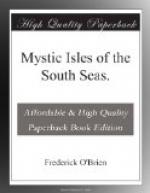But if one dropped one’s eyes from the hills, gone was the recollection of aught of Europe. There was a scene which only the lavish colors of the tropics could furnish. The artist had spilled all his shades of green upon the palette, and so delicately blended them that they melted into one another in a very enchantment of green. The valleys were but darker variants of the emerald scheme.
The confused mass of lofty ridges resolved into chasms and combes, dark, sunless ravines, moist with the spray of many waterfalls, which nearer became velvet valleys of pale green, masses of foliage and light and shadow. The mountains of Moorea were only half the height of Tahiti’s, but so artfully had they been piled in their fantastic arrangement that they seemed as high, though they were entirely different in their impress upon the beholder. Tahiti from the sea was like a living being, so vivid, so palpitating was its contour and its color, but Moorea, when far away, was cold and black, a beautiful, ravishing sight, but like the avatars of a race of giants that had passed, a sepulcher or monument of their achievements and their end.
As about Tahiti, a silver belt of reef took the rough caresses of the lazy rollers, and let the glistening surf break gently on the beach. Along this wall of coral, hidden, but charted by its crown of foam, we ran for miles until we found the gateway—the blue buckle of the belt, it appeared at a distance.
Within the lagoon the guise of the island was more intimate. Little bays and inlets bounded themselves, and villages and houses sprang up from the tropic groves. The band, which so far as I knew had not been silent a moment to awaken me from my adoration of the sculpture and painting of nature, now poured out the “Himene Tatou Arearea” in token of our approaching landing, which was at Faatoai, the center of population. All its hundred or two inhabitants were at the tiny dock to greet us, except the Chinese, who stayed in their stores.
Headed by the pipe and accordion, the brass and wood, now playing “Onward, Christian Soldier,”—which, if one forgot the words, was an especially carnal melody,—we tramped, singing a parody, through the street of Faatoai, and into a glorious cocoanut grove, where breakfast was spread.
A pavilion had been erected for our feasting. It was of bamboo and pandanus, the interior lined with tree ferns and great bunches of scarlet oleander, and decorated with a deep fringe woven of hibiscus fiber. The roof was a thatch of pandanus and breadfruit leaves, the whole structure, light, flimsy, but a gamut of golds and browns in color and cool and beautiful.




